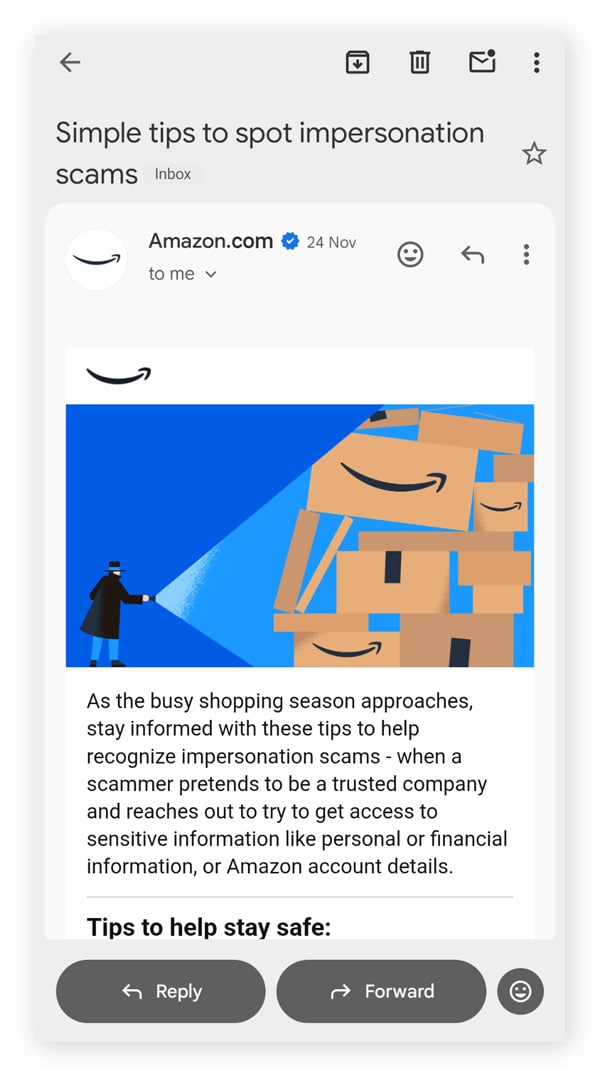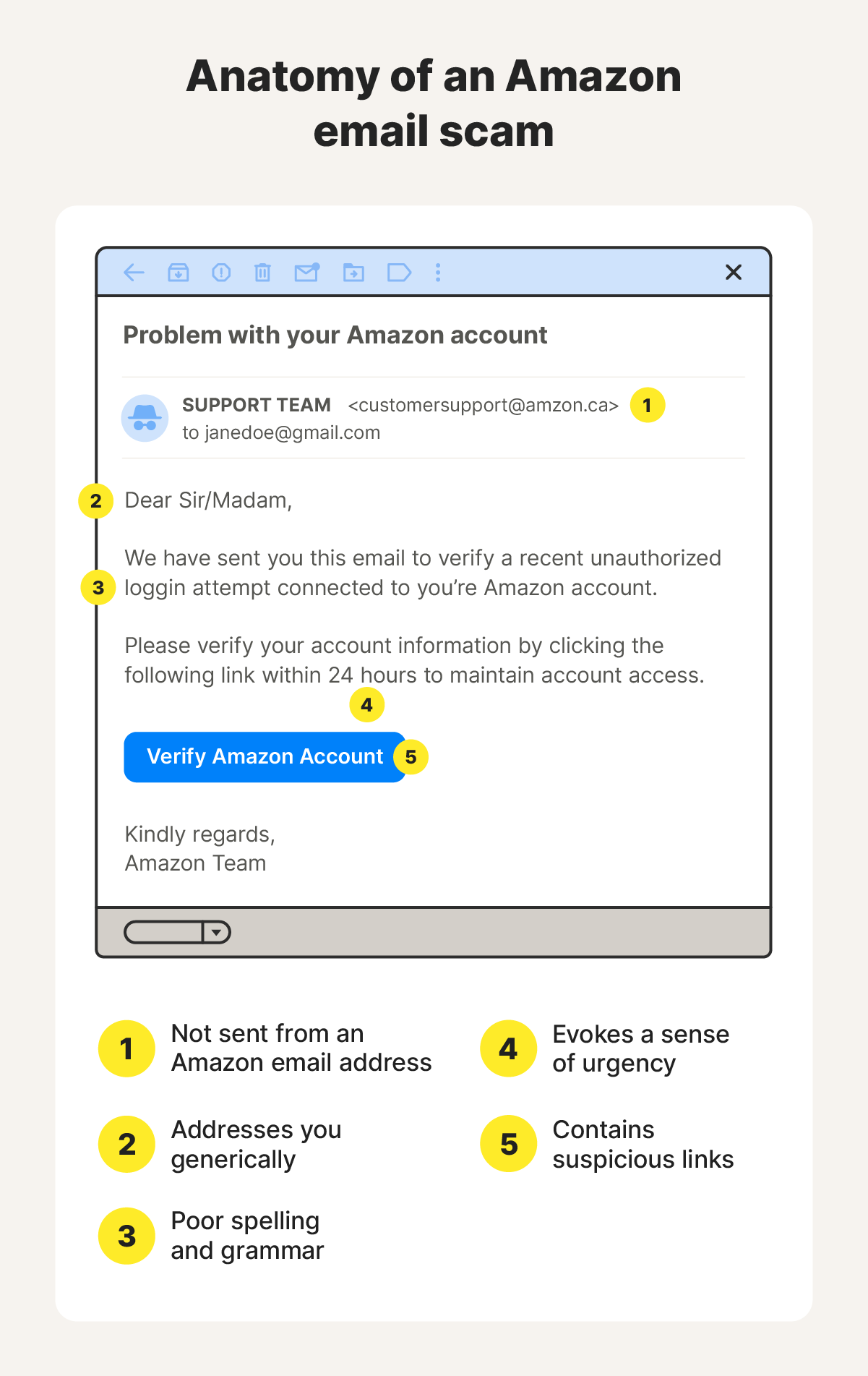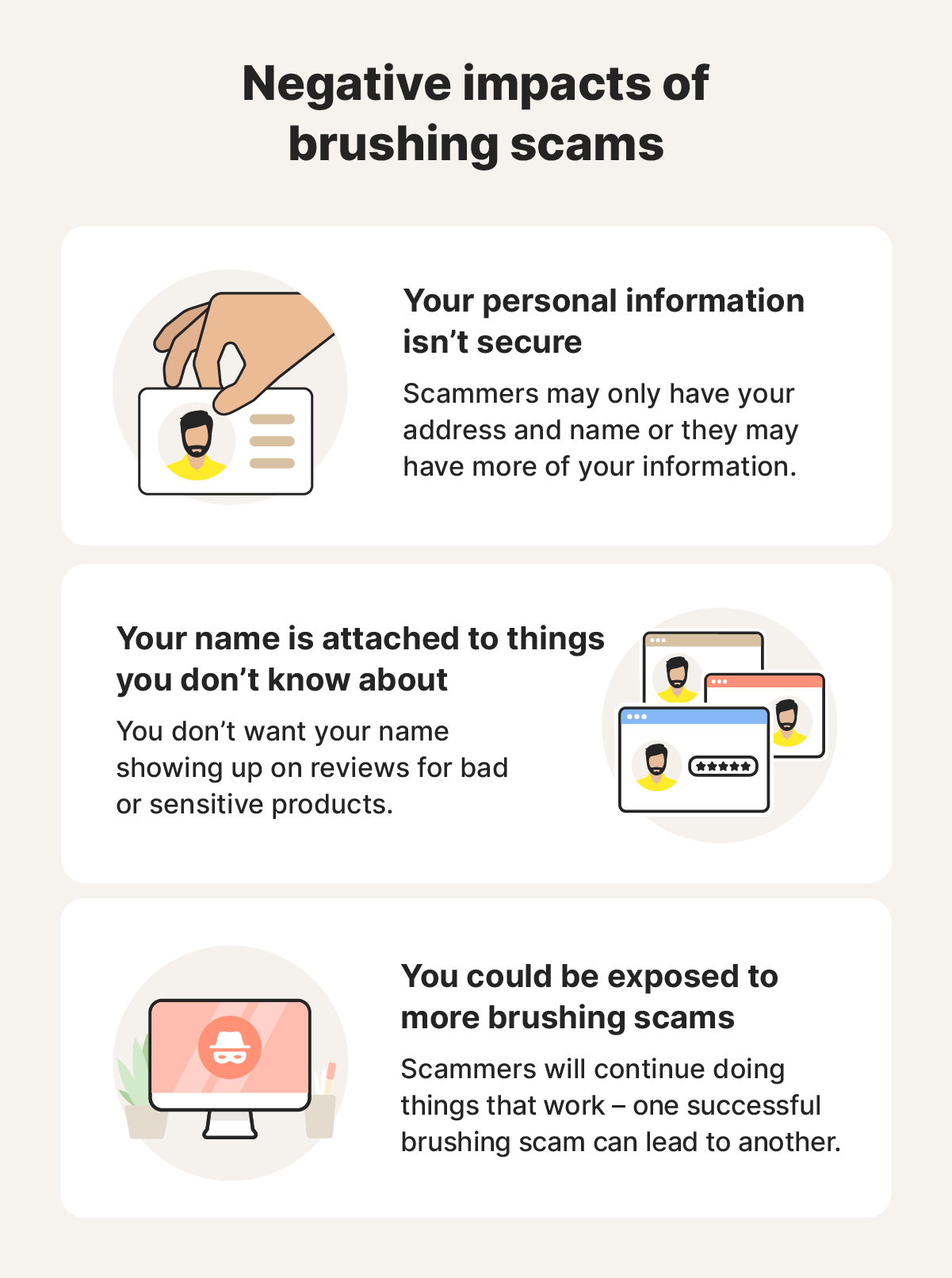Follow Amazon’s safety tips, stay on guard during the holiday season, and remember: Amazon will never ask you for payment details or account credentials over the phone or in an unsolicited email. Only make payments on the official Amazon app.
Amazon scammers are people who take advantage of Amazon’s popularity to swindle people out of sensitive information and money. Federal Trade Commission (FTC) data shows that consumers reported losing more than $12.5 billion to fraud in 2024. And many fraud losses start as phishing attacks, where fraudsters mimic trusted platforms like Amazon to trick individuals into revealing personal or financial information.
But Amazon scams go way beyond just phishing. Understanding how different Amazon scams work can help you spot them and protect yourself. Read on to learn about 14 common Amazon scams and get tips to avoid falling for them.
1. Amazon impersonation scams
Amazon is one of the most commonly impersonated companies in scams — a fact that the ecommerce giant is likely well aware of. In the run-up to the 2025 holiday season, Amazon sent an email to millions of users warning about the risk of impersonation scams, which happen when a scammer pretends to be contacting you from Amazon and attempts to get you to share sensitive information like your personal or financial details.
Here’s a screenshot of the Amazon email I received in November 2025.


The warning email lists some example impersonation scam tactics that might be in play during the holiday season, including:
- Fake messages claiming to be about delivery or account issues.
- Third-party social media posts and ads with deals that seem too good to be true.
- Messages through unofficial channels asking for your password or payment information.
- Unfamiliar links asking you to verify your account credentials through a fake website.
- Unsolicited phone calls claiming to be from Amazon tech support.
And the email also provides some key tips you can use to stay safe, including setting up two-factor authentication (2FA), using a passkey, and ignoring messages that try to create a sense of urgency.
2. Email scams
Amazon email scams involve phishing emails that falsely claim an issue with your account or order. These messages pressure you into sharing personal information like your Amazon password or credit card information to resolve the “problem.” Scammers then exploit this data to hijack your account or make unauthorized purchases.
Amazon email scam warning signs:
- Emails with poor grammar, typos, or misspellings.
- Messages pressuring you into immediate action.
- Emails containing links to websites that mimic Amazon, but with misspelled URLs.
- Requests for payment via gift cards, cryptocurrency, or third-party money transfers.
If you’re unsure whether an Amazon email is legitimate, check the Amazon Message Center from within your Amazon account. This is where all official correspondence from Amazon is stored. If the email you received isn’t in the Message Center, it’s likely a scam.


3. iPhone scams
This trending Amazon scam starts with a call from a fake Amazon representative claiming your account is compromised. They direct you to check your cart, where you’ll see expensive items — like iPhones — that you never added. To "secure" your account, they request credit card details, remote access to your computer, or direct you to click malicious links, ultimately stealing your money or data.
In one viral TikTok video, a user named Molly describes almost falling for this scam when she received a call from someone pretending to be Amazon support. Fortunately, the scammer’s unprofessional demeanor alerted her to the ruse before it was too late.
Amazon iPhone scam warning signs:
- Receiving calls with significant background noise as if the call is coming from a busy call center.
- Multiple expensive items in your Amazon shopping cart that you never added.
- Requests to divulge personal information.
Although Amazon may occasionally call customers, they will never request sensitive information over the phone. If a caller asks for details like your password or payment information, it’s a scam. Protect your credit card information by hanging up imminently.
4. Amazon Prime membership scams
The Amazon Prime membership scam targets you with unexpected emails, calls, or texts informing you that your Amazon Prime membership is about to expire. These messages often claim that you’ll face a large fee if you don’t respond quickly.
Scammers may request personal information or direct you to click on suspicious links, all with the intent of stealing your payment details or gaining access to your device.
Amazon Prime membership scam warning signs:
- Receiving unexpected contact from someone claiming there’s an issue with your Amazon Prime account (you may not even have one).
- Threats of large fees to pressure you into acting quickly.
- Requests for personal information, such as login credentials or credit card details.
5. Account suspension scams
If you receive a text or email stating your Amazon account is suspended due to suspicious activity, be cautious — it could be a scam. While Amazon may suspend accounts for security reasons, scammers exploit this tactic to trick you into sharing personal information, potentially leading to identity theft or account takeover.
These messages often mention issues with billing information and provide a link to “fix” the problem. Clicking the link leads to a fake website designed to steal your personal information if you enter any details.
Amazon account suspension scam warning signs:
- Receiving texts about an issue with your Amazon account, even though there are no signs of any problems.
- Messages claiming you have 24 hours to resolve the issue before your account is suspended.
- Texts including suspicious links that lead to fake websites.
- You can log into your Amazon account as normal, and there aren’t any alerts about suspicious activity in-app.
Before clicking on any link, hover over it to check the URL. Genuine Amazon links will always end with “Amazon.com.” If the URL looks unfamiliar or doesn’t match, it’s likely a scam.
6. Brushing scams
A brushing scam is a type of e-commerce fraud where scammers send unsolicited packages to people to create fake transactions. In Amazon brushing scams, fraudsters use your name and address to set up fake accounts, send you packages you didn’t order, and then post false reviews to boost their products’ rankings and credibility. Amazon brushing scam warning signs include:
- Receiving packages from Amazon that you didn’t order.
- Receiving packages without a return address.
- Seeing your name linked to product reviews you didn’t write.
While these scams may seem harmless at first, they could signal that your personal data has leaked online, increasing your risk of identity theft and financial fraud.


Investing in an identity theft protection service like LifeLock Standard can shield you from the risks associated with brushing scams by helping you remove your personal details from public data broker sites, and notify you if your information is found on the dark web.
7. Gift card scams
In Amazon gift card scams, cybercriminals pose as trusted figures, like family members, government officials, or tech support agents. They use threatening language or fake emergencies to trick you into sending Amazon gift cards as payment.
These scammers often create urgent, false scenarios, like claiming they’re a friend in danger or posing as your utility company and claiming you have an unpaid bill, pressuring you to act quickly without thinking twice. This false sense of urgency is nearly always a sign you’re communicating with a scammer.
Scammers prefer gift cards over credit card payments because they’re harder to trace and nearly impossible to recover, giving them quick access to funds with minimal risk of getting caught.
Amazon gift card scam warning signs:
- Messages claiming you owe money for something urgent, like taxes or utility bills, with threats of severe consequences.
- Requests for payment via Amazon gift cards.
- Messages using aggressive and threatening language to pressure you into complying.
Legitimate organizations will never request payment via gift cards. If you receive such a request, ignore it. In case of any doubts, contact the organization directly using the official contact information from their website.
8. Off-platform payment scams
In Amazon off-platform payment scams, fraudulent sellers or individuals impersonating Amazon trick you into paying for a product outside the Amazon website or app. Since off-platform payments aren’t covered by Amazon’s A-to-z Guarantee, you risk losing your money to scammers, who may deliver low-quality products or nothing at all.
One Redditor shared their experience with a suspicious email seemingly from Amazon requesting an off-platform payment.
The email stated that payment for their order had failed and requested a bank transfer of €400 to a personal account, urging the user to pay quickly to avoid cancellation.
Amazon off-platform payment scam warning signs:
- Requests for payment via Zelle, Cash App, or other external links.
- Emails that appear to come from Amazon, but the sender’s email address does not end with @amazon.com.
9. Typosquatting scams
Amazon typosquatting scams occur when scammers create fake websites with URLs that closely resemble Amazon’s official site, like “Anazon.com.” Their goal is to trick you into entering payment details, thinking you’re on the legitimate Amazon site. Once the scammer has this information, they can steal your money or commit identity theft.
Amazon typosquatting scam warning sings:
- URLs that look similar to Amazon.com but have slight differences, like misspellings or unusual domain endings.
- Websites lacking security features, such as “https” or a padlock icon in the browser near the URL.
- Websites containing typos, grammatical errors, or low-quality design elements.
Always verify the URL before entering personal or payment information, and ensure you’re using the official Amazon website: www.amazon.com.
10. Delivery driver scams
The Amazon delivery driver scam is a phishing scheme where scammers pose as Amazon drivers and send text messages claiming there’s an issue with your delivery. These messages aim to trick you into clicking on a link or providing sensitive information, which can lead to identity theft or stolen payment details.
Amazon driver scam warning signs:
- Text messages about delivery issues when you aren’t expecting a delivery.
- Messages containing false claims that payment is required to receive your package.
- You can’t find any communication about the issue in the Amazon Message Center.
Scammers exploit the fact that Amazon drivers can text customers, making fake messages harder to spot. But since your purchase is already paid for, Amazon will never ask for extra payment to complete the delivery.
11. Fake refund scams
In this scam, fraudsters impersonate Amazon representatives and claim you’re eligible for a refund due to a billing error or fraudulent activity. To “process” the refund, they ask for personal information, request remote access to your device, or direct you to a fake website, compromising your accounts and stealing your money.
One Redditor shared their Amazon refund scam experience where they received a “damaged shipment” notice, they got a text offering a refund via a link requesting bank details. Sensing red flags, they contacted Amazon and confirmed it was a scam.
Amazon fake refund scam warning signs:
- You receive unsolicited calls, texts, or emails claiming to be from Amazon or their “account services” department.
- You hear vague explanations for why a refund is owed.
- The scammer asks for remote access to your device or personal information.
12. Hijacked listing scams
In the Amazon hijacked listing scam, fraudsters alter legitimate listings by changing the title, images, and description to advertise a different, unrealistically cheap product. The original reviews make it seem trustworthy, but buyers often receive counterfeit or low-quality items.
Amazon hijacked listing scam warning signs:
- Products advertised at steep discounts that seem too good to be true.
- Positive reviews that don’t align with the product being sold.
- Inconsistent product descriptions, images, or specifications.
Before purchasing, read the product description, reviews, and seller information carefully. If details don’t align or the deal seems suspicious, avoid purchasing and report the listing to Amazon.
13. Mystery box scams
Amazon mystery box scams use enticing ads, emails, or social media posts to try to tempt shoppers with promises of high-value surprise items at unbelievably low prices. Scammers claim you can win them by completing a quick survey and paying a small shipping fee. In reality, their goal is to steal your money or personal information, leaving you with poor-quality items or nothing at all.
Amazon mystery box scam warning signs:
- Mystery box listings offering luxury or high-value items for suspiciously low prices.
- The listing includes poor-quality product images.
- You receive unsolicited offers to claim your Amazon mystery box.
14. Account takeovers
Amazon account takeovers happen when scammers exploit stolen credentials from data breaches, phishing attacks, or the dark web to access your account. Once inside, they make unauthorized purchases, change account details, or steal sensitive information. This is often the end result of many of the other scams mentioned above.
Amazon account takeover scam warning signs:
- Login alerts or password reset emails for your Amazon account that you didn’t request.
- Your Amazon gift card balance disappears overnight.
- Unfamiliar purchases in your order history or billing statements.
- Changes to your account information, such as your shipping address or payment methods.
- You’re suddenly locked out of your Amazon account.
Use a strong, unique password to protect your Amazon account, and consider using a password manager to generate and store them securely.
How to protect yourself from Amazon scams
To protect yourself from Amazon scams, it’s important to recognize scam signs and take the necessary cybersecurity precautions. Use the following best practices to keep yourself safer while shopping on Amazon:
- Use two-factor authentication: Add an extra layer of security to your account by requiring a code from your phone or email in addition to your password.
- Invest in identity theft protection: Identity theft protection services, like LifeLock Standard, notify you if your personal information appears in suspicious places, like the dark web.
- Check the Amazon Message Center: This is where Amazon stores all official communication so you can confirm whether a message or order update is legitimate.
- Verify the URL: Always ensure you’re on the official Amazon website by looking for “https://www.amazon.com” in the address bar before logging in or entering sensitive information.
- Use strong passwords: Creating strong and unique passwords for all your accounts reduces your risk of falling victim to credential stuffing.
- Don’t click suspicious links: Avoid clicking suspicious links or attachments in emails or text messages. They may lead to phishing websites or malware downloads.
- Stay on the Amazon platform: Amazon’s A-to-z Guarantee protects purchases made on the platform. You lose that protection if you pay for items somewhere else.
What to do if you fell for an Amazon scam
If you fall victim to an Amazon scam, it’s important to act quickly to minimize the impact and help protect your Amazon account, finances, and identity.
- Report the scam to Amazon: Notify Amazon of the scam by contacting their customer service or visiting the Amazon Report a Scam page. Reporting the incident helps Amazon investigate and potentially shut down fraudulent activities.
- Notify your financial institutions: Immediately inform your bank and credit card provider about the scam. They can help you stop unauthorized transactions, issue new cards, or reverse charges in some cases.
- Contact the FTC: To help authorities combat the scam, file a report with the Federal Trade Commission (FTC).
- Review recent Amazon purchases: Check your Amazon order history for unauthorized purchases or charges. If you find any, report them to Amazon and your payment provider to dispute the charges.
- Keep tabs on your financial accounts: Monitor your bank accounts and credit card statements regularly for unusual transactions. Report any suspicious activity to your financial institution.
- Freeze your credit: You can freeze your credit with the major credit bureaus to prevent identity thieves from opening new accounts in your name.
- Create a fraud alert: Add a fraud alert to your credit report to notify potential lenders to verify your identity before issuing new credit.
Stay safe while you shop with LifeLock
Understanding how Amazon scams work and how to protect yourself can help you use the platform safely. But for added peace of mind in today’s rapidly evolving fraud landscape, consider investing in identity protection.
LifeLock Standard helps safeguard you from identity theft by scouring the dark net for data leaks, alerting you if your information is found. It will also help you remove your details from public people-search websites. And if you do fall victim, LifeLock’s expert U.S.-based restoration specialists will help you restore your identity.
FAQs
Can you get scammed on Amazon?
Yes, scams on Amazon can occur through fake sellers, counterfeit products, and fraudulent third-party listings. Scammers may lure buyers with low prices, then fail to deliver items or steal personal information. Always verify seller ratings, check reviews, and avoid suspicious links to stay safe while shopping.
Does Amazon contact you by phone?
Amazon may occasionally call customers about suspicious transactions, such as sudden large gift card purchases. However, they will only ask you to confirm or deny specific transactions and will never request personal information or account details.
Does Amazon notify you of suspicious activity?
Yes, Amazon takes account security seriously. If they notice suspicious activity, like unusual logins or charges, they’ll notify you via email or text to help keep your account secure.
Can you get a refund if you get scammed on Amazon?
If you fall victim to a scam on the Amazon platform, they usually advise you to file a chargeback with your bank. In some rare cases, Amazon may issue a refund.
Amazon is a trademark of Amazon.com, Inc.
Editor’s note: Our articles provide educational information. LifeLock offerings may not cover or protect against every type of crime, fraud, or threat we write about.
This article contains
- 1. Amazon impersonation scams
- 2. Email scams
- 3. iPhone scams
- 4. Amazon Prime membership scams
- 5. Account suspension scams
- 6. Brushing scams
- 7. Gift card scams
- 8. Off-platform payment scams
- 9. Typosquatting scams
- 10. Delivery driver scams
- 11. Fake refund scams
- 12. Hijacked listing scams
- 13. Mystery box scams
- 14. Account takeovers
- How to protect yourself from Amazon scams
- What to do if you fell for an Amazon scam
- Stay safe while you shop with LifeLock
- FAQs
Start your protection,
enroll in minutes.
LifeLock is part of Gen – a global company with a family of trusted brands.
Copyright © 2025 Gen Digital Inc. All rights reserved. Gen trademarks or registered trademarks are property of Gen Digital Inc. or its affiliates. Firefox is a trademark of Mozilla Foundation. Android, Google Chrome, Google Play and the Google Play logo are trademarks of Google, LLC. Mac, iPhone, iPad, Apple and the Apple logo are trademarks of Apple Inc., registered in the U.S. and other countries. App Store is a service mark of Apple Inc. Alexa and all related logos are trademarks of Amazon.com, Inc. or its affiliates. Microsoft and the Window logo are trademarks of Microsoft Corporation in the U.S. and other countries. The Android robot is reproduced or modified from work created and shared by Google and used according to terms described in the Creative Commons 3.0 Attribution License. Other names may be trademarks of their respective owners.







